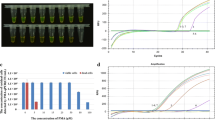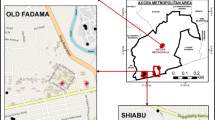Abstract
It is well established that the contamination sources of cholera causing bacteria, Vibrio cholerae, are water and food, but little is known about the transmission role of the fomites (surfaces that can carry pathogens) commonly used in households. In the absence of appropriate nutrients or growth conditions on fomites, bacteria have been known to assume a viable but non-culturable (VBNC) state after a given period of time. To investigate whether and when V. cholerae O1 assumes such a state, this study investigated the survival and viable quantification on a range of fomites such as paper, wood, glass, plastic, cloth and several types of metals under laboratory conditions. The fomites were inoculated with an outbreak strain of V. cholerae and its culturability was examined by drop plate count method at 30 min intervals for up to 6 h. For molecular detection, the viable/dead stain ethidium monoazide (EMA) which inhibits amplification of DNA from dead cells was used in combination with real-time polymerase chain reaction (EMA-qPCR) for direct quantitative analyses of viable V. cholerae at 2, 4, 6, 24 h and 7 day time intervals. Results showed that V. cholerae on glass and aluminum surfaces lost culturability within one hour after inoculation but remained culturable on cloth and wood for up to four hours. VBNC V. cholerae on dry fomite surfaces was detected and quantified by EMA-qPCR even 7 days after inoculation. In conclusion, the prolonged survival of V. cholerae on various household fomites may play vital role in cholera transmission and needs to be further investigated.



Similar content being viewed by others
References
Abrishami S, Tall B, Bruursema T, Epstein P, Shah D (1994) Bacterial adherence and viability on cutting board surfaces. J Food Saf 14(2):153–172
Ali M, Lopez AL, You Y, Kim YE, Sah B, Maskery B, Clemens J (2012) The global burden of cholera. Bull World Health Organ 90:209–218
Ali M, Nelson AR, Lopez AL, Sack DA (2015) Updated global burden of cholera in endemic countries. PLoS Negl Trop Dis 9(6):e0003832. doi:10.1371/journal.pntd.0003832
Barua D (1970) Survival of cholera vibrios in food, water and fomites. Public Health Pap 40:29–31
Blackstone GM, Nordstrom JL, Bowen MD, Meyer RF, Imbro P, DePaola A (2007) Use of a real time PCR assay for detection of the ctxA gene of Vibrio cholerae in an environmental survey of Mobile Bay. J Microbiol Methods 68:254–259. doi:10.1016/j.mimet.2006.08.006
Butler SM, Nelson EJ, Chowdhury N, Faruque SM, Calderwood SB, Camilli A (2006) Cholera stool bacteria repress chemotaxis to increase infectivity. Mol Microbiol 60:417–426
Cash R, Music S, Libonati J, Craig J, Pierce N, Hornick R (1974a) Response of man to infection with Vibrio cholerae. II. Protection from illness afforded by previous disease and vaccine. J Infect Dis 130:325–333
Cash RA, Music SI, Libonati JP, Snyder MJ, Wenzel RP, Hornick RB (1974b) Response of man to infection with Vibrio cholerae. I. Clinical, serologic, and bacteriologic responses to a known inoculum. J Infect Dis 129:45–52
Cholera vaccines: WHO position paper (2010) Wkly Epidemiol Rec 85(13):117–128
Colwell RR (2009) Viable but not cultivable bacteria. In: Epstein SS (ed) Uncultivated microorganisms. Springer, Berlin, pp 121–129. doi:10.1007/978-3-540-85465-4_1
Colwell R, Brayton P, Herrington D, Tall B, Huq A, Levine M (1996) Viable but non-culturable Vibrio cholerae O1 revert to a cultivable state in the human intestine. World J Microbiol Biotechnol 12:28–31
De Medici D, Croci L, Delibato E, Di Pasquale S, Filetici E, Toti L (2003) Evaluation of DNA extraction methods for use in combination with SYBR green I real-time PCR to detect Salmonella enterica serotype enteritidis in poultry. Appl Environ Microbiol 69:3456–3461
Drasar B (1995) Vibrio cholerae and cholera: molecular to global perspectives. Trans R Soc Trop Med Hyg 89:580
Eisenberg MC, Robertson SL, Tien JH (2013) Identifiability and estimation of multiple transmission pathways in cholera and waterborne disease. J Theor Biol 324:84–102
El-Din El-Dars FM, Hassan WM (2005) A preliminary bacterial study of Egyptian paper money. Int J Environ Health Res 15:235–240
Glass RI, Black RE (1992) The epidemiology of cholera. In: Barua D, Greenough WB (eds) cholera. Springer, Boston, pp 129–154. doi:10.1007/978-1-4757-9688-9_7
Glass RI, Blake P, Waldman R, Claeson M, Pierce NF (1991) Cholera in Africa: lessons on transmission and control for Latin America. Lancet 338:791–795
Huq A, Small EB, West PA, Huq MI, Rahman R, Colwell RR (1983) Ecological relationships between Vibrio cholerae and planktonic crustacean copepods. Appl Environ Microbiol 45:275–283
Islam M, Drasar B, Bradley D (1990) Long-term persistence of toxigenic Vibrio cholerae O1 in the mucilaginous sheath of a blue-green alga, Anabaena variabilis. J Trop Med Hyg 93:133–139
Islam M, Hasan M, Miah M, Sur G, Felsenstein A, Venkatesan M, Sack R, Albert M (1993) Use of the polymerase chain reaction and fluorescent-antibody methods for detecting viable but nonculturable Shigella dysenteriae type 1 in laboratory microcosms. Appl Environ Microbiol 59:536–540
Islam MS, Hossain M, Khan S, Khan M, Sack R, Albert MJ, Huq A, Colwell R (2001) Survival of Shigella dysenteriae type 1 on fomites. J Health Popul Nutr 19:177–182
Keer J, Birch L (2003) Molecular methods for the assessment of bacterial viability. J Microbiol Methods 53:175–183
Kendall EA, Chowdhury F, Begum Y, Khan AI, Li S, Thierer JH, Bailey J, Kreisel K, Tacket CO, LaRocque RC (2010) Relatedness of Vibrio cholerae O1/O139 isolates from patients and their household contacts, determined by multilocus variable-number tandem-repeat analysis. J Bacteriol 192:4367–4376
Kramer A, Schwebke I, Kampf G (2006) How long do nosocomial pathogens persist on inanimate surfaces? A systematic review. BMC Infect Dis 6:130
Levine M, Black R, Clements M, Nalin D, Cisneros L, Finkelstein R (1981) Volunteer studies in development of vaccines against cholera and enterotoxigenic Escherichia coli: a review. In: Holme T, Holmgren J, Merson MH, MolIby R (eds) Acute enteric infections in children. New prospects for treatment and prevention. Elsevier/North-Holland Publishing Co., Amsterdam, pp 443–459
Lim VK (2001) Cholera: a re-emerging infection. Med J Malays 56:1–3
Makison C, Swan J (2006) The effect of humidity on the survival of MRSA on hard surfaces. Indoor Built Environ 15:85–91
Mandal S, Mandal MD, Pal NK (2011) Cholera: a great global concern. Asian Pac J Trop Med 4:573–580
Merrell DS, Butler SM, Qadri F, Dolganov NA, Alam A, Cohen MB, Calderwood SB, Schoolnik GK, Camilli A (2002) Host-induced epidemic spread of the cholera bacterium. Nature 417:642–645
Milling A, Kehr R, Wulf A, Smalla K (2005) Survival of bacteria on wood and plastic particles: dependence on wood species and environmental conditions. Holzforschung 59:72–81
Mishra A, Taneja N, Sharma M (2012) Viability kinetics, induction, resuscitation and quantitative real-time polymerase chain reaction analyses of viable but nonculturable Vibrio cholerae O1 in freshwater microcosm. J Appl Microbiol 112:945–953
Nandi B, Nandy RK, Mukhopadhyay S, Nair GB, Shimada T, Ghose AC (2000) Rapid method for species-specific identification ofVibrio cholerae using primers targeted to the gene of outer membrane protein OmpW. J Clin Microbiol 38:4145–4151
Neely AN, Maley MP (2000) Survival of enterococci and staphylococci on hospital fabrics and plastic. J Clin Microbiol 38:724–726
Nelson EJ, Chowdhury A, Flynn J, Schild S, Bourassa L, Shao Y, LaRocque RC, Calderwood SB, Qadri F, Camilli A (2008) Transmission of Vibrio cholerae is antagonized by lytic phage and entry into the aquatic environment. PLoS Pathog 4:e1000187
Nelson EJ, Harris JB, Morris JG, Calderwood SB, Camilli A (2009) Cholera transmission: the host, pathogen and bacteriophage dynamic. Nat Rev Microbiol 7:693–702
Nocker A, Camper AK (2006) Selective removal of DNA from dead cells of mixed bacterial communities by use of ethidium monoazide. Appl Environ Microbiol 72:1997–2004
Nogva HK, Dromtorp S, Nissen H, Rudi K (2003) Ethidium monoazide for DNA-based differentiation of viable and dead bacteria by 5′-nuclease PCR. Biotechniques 34:804–813
Noskin GA, Stosor V, Cooper I, Peterson LR (1995) Recovery of vancomycin-resistant enterococci on fingertips and environmental surfaces. Infect Control Hosp Epidemiol 16:577–581
Noskin GA, Bednarz P, Suriano T, Reiner S, Peterson LR (2000) Persistent contamination of fabric-covered furniture by vancomycin-resistant enterococci: implications for upholstery selection in hospitals. Am J Infect Control 28:311–313
Pittet D, Allegranzi B, Sax H, Dharan S, Pessoa-Silva CL, Donaldson L, Boyce JM (2006) Evidence-based model for hand transmission during patient care and the role of improved practices. Lancet Infect Dis 6:641–652
Pollitzer R, Swaroop S, Burrows W (1959) Cholera. Monogr Ser World Health Organ 58:1001–1019
Reuter S, Sigge A, Wiedeck H, Trautmann M (2002) Analysis of transmission pathways of Pseudomonas aeruginosa between patients and tap water outlets. Crit Care Med 30:2222–2228
Rollins D, Colwell R (1986) Viable but nonculturable stage of Campylobacter jejuni and its role in survival in the natural aquatic environment. Appl Environ Microbiol 52:531–538
Roszak DB, Colwell RR (1987) Survival strategies of bacteria in the natural environment. Microbiol Rev 51:365–379
Rudi K, Moen B, Dromtorp SM, Holck AL (2005) Use of ethidium monoazide and PCR in combination for quantification of viable and dead cells in complex samples. Appl Environ Microbiol 71:1018–1024. doi:10.1128/AEM.71.2.1018-1024.2005
Rusin P, Maxwell S, Gerba C (2002) Comparative surface-to-hand and fingertip-to-mouth transfer efficiency of gram-positive bacteria, gram-negative bacteria, and phage. J Appl Microbiol 93:585–592
Sack DA, Sack RB, Nair GB, Siddique AK (2004) Cholera. Lancet 363:223–233
Scott E, Bloomfield SF (1990) The survival and transfer of microbial contamination via cloths, hands and utensils. J Appl Bacteriol 68:271–278
Sehulster L, Chinn RY (2003) Guidelines for environmental infection control in health-care facilities: recommandations of CDC and the Healthcare Infection Control Practices Advisory Committee (HICPAC). MMWR Recomm Rep 52(RR-10):1–42
Snow J (1855) On the mode of communication of cholera, 2nd edn. John Churchill, London
Sugimoto JD, Koepke AA, Kenah EE, Halloran ME, Chowdhury F, Khan AI, LaRocque RC, Yang Y, Ryan ET, Qadri F (2014) Household transmission of Vibrio cholerae in Bangladesh. PLoS Negl Trop Dis 8:e3314
Taylor J, Davies M, Canales M, Man Lai K (2013) The persistence of flood-borne pathogens on building surfaces under drying conditions. Int J Hyg Environ Health 216:91–99
Todd EC, Greig JD, Bartleson CA, Michaels BS (2008) Outbreaks where food workers have been implicated in the spread of foodborne disease. Part 4. Infective doses and pathogen carriage. J Food Prot® 71:2339–2373
Todd EC, Greig JD, Bartleson CA, Michaels BS (2009) Outbreaks where food workers have been implicated in the spread of foodborne disease. Part 6. Transmission and survival of pathogens in the food processing and preparation environment. J Food Prot® 72:202–219
Vriesekoop F, Russell C, Alvarez-Mayorga B, Aidoo K, Yuan Q, Scannell A, Beumer RR, Jiang X, Barro N, Otokunefor K (2010) Dirty money: an investigation into the hygiene status of some of the world’s currencies as obtained from food outlets. Foodborne Pathog Dis 7:1497–1502
Williams A, Avery L, Killham K, Jones D (2005) Persistence of Escherichia coli O157 on farm surfaces under different environmental conditions. J Appl Microbiol 98:1075–1083
Xu H-S, Roberts N, Singleton F, Attwell R, Grimes D, Colwell R (1982) Survival and viability of nonculturable Escherichia coli and Vibrio cholerae in the estuarine and marine environment. Microb Ecol 8:313–323
Zahid MSH, Udden SN, Faruque A, Calderwood SB, Mekalanos JJ, Faruque SM (2008) Effect of phage on the infectivity of Vibrio cholerae and emergence of genetic variants. Infect Immun 76:5266–5273
Acknowledgments
This study was funded by the project entitled “Combating Cholera Caused by Climate Change in Bangladesh, C5” (Grant No. 12-040KU) from Danish International Development Agency. We acknowledge International Centre for Diarrheal Disease (icddr, b) Bangladesh for providing the bacterial strain.
Author information
Authors and Affiliations
Corresponding author
Ethics declarations
Conflict of interest
The authors declare that they have no conflict of interest.
Rights and permissions
About this article
Cite this article
Farhana, I., Hossain, Z.Z., Tulsiani, S.M. et al. Survival of Vibrio cholerae O1 on fomites. World J Microbiol Biotechnol 32, 146 (2016). https://doi.org/10.1007/s11274-016-2100-x
Received:
Accepted:
Published:
DOI: https://doi.org/10.1007/s11274-016-2100-x




